To capture stunning water reflection photos with your phone, start by finding a calm water source like a lake or puddle. Shoot during golden hour for soft, warm light, and use both hands or a tripod to stabilize your device. Clean your lens thoroughly and adjust your camera settings, focusing on the point where the reflection meets the shoreline. Frame your shot using the rule of thirds and experiment with different angles for unique perspectives. After capturing your image, enhance it with editing apps to adjust colors and contrast. With these tips, you'll be well on your way to creating mesmerizing reflection shots that'll leave viewers in awe.
Find the Perfect Water Source
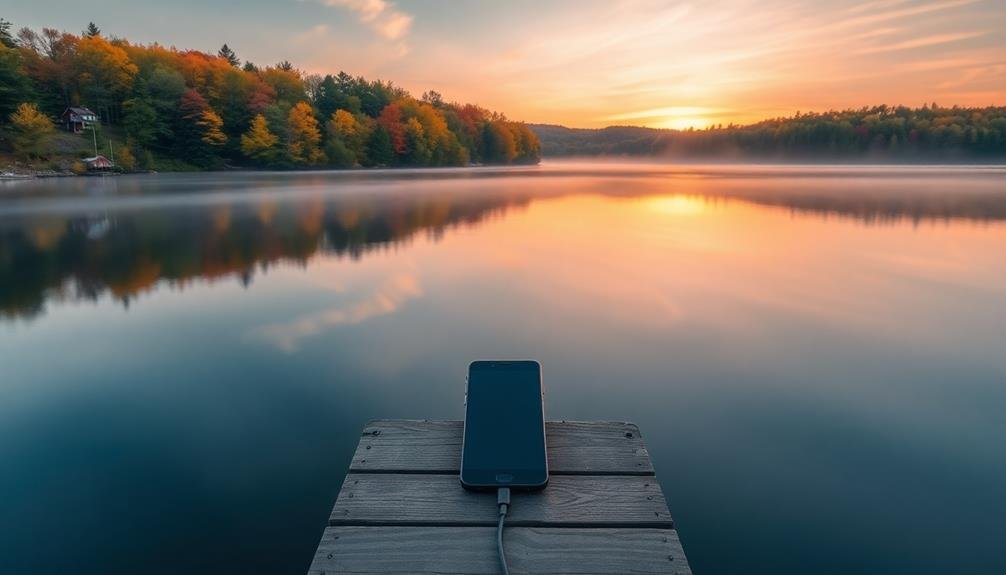
When seeking the perfect water source for reflection photography, you'll want to look for calm, still bodies of water. Lakes, ponds, and even puddles can provide excellent reflective surfaces. The key is to find water that's as smooth as glass, with minimal ripples or disturbances.
Time of day plays a vital role in finding the ideal water source. Early morning or late evening, when the wind is typically calmer, often offer the best conditions for reflection photography.
You'll also want to take into account the surrounding environment. Look for interesting elements like trees, mountains, or buildings that can create enchanting reflections.
Don't overlook man-made water sources. Fountains, swimming pools, and even wet pavements after rain can produce stunning reflective images.
When scouting locations, pay attention to the water's cleanliness and clarity. Murky or debris-filled water won't yield the crisp reflections you're after.
Lastly, think about the accessibility of the water source. Confirm you can safely position yourself and your phone to capture the best angle without risking your safety or damaging your equipment.
Time Your Shoot Right
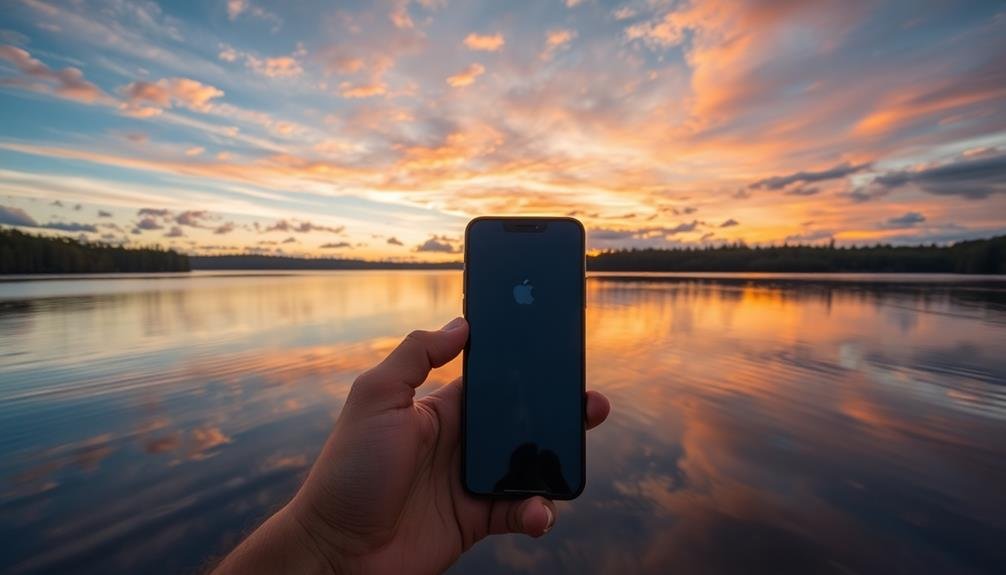
Timing your shoot perfectly can make or break your water reflection photos. To capture stunning images, aim for the golden hour – the period shortly after sunrise or before sunset. During this time, the soft, warm light creates a magical atmosphere and enhances the reflections on the water's surface.
Consider the weather conditions as well. A calm day with little to no wind is ideal for capturing clear reflections. Overcast skies can provide even lighting and help prevent harsh shadows, while partly cloudy days offer opportunities for dramatic shots as the clouds reflect on the water.
Keep an eye on the water level, too. A higher water level often results in smoother, more mirror-like reflections. If you're shooting at a location affected by tides, check the tide tables to plan your visit during high tide.
Don't forget to experiment with different times of day. Early morning mist can add an ethereal quality to your photos, while late afternoon light can create long, dramatic shadows.
Be patient and willing to revisit a location multiple times to capture the perfect conditions for your reflection shots.
Stabilize Your Smartphone
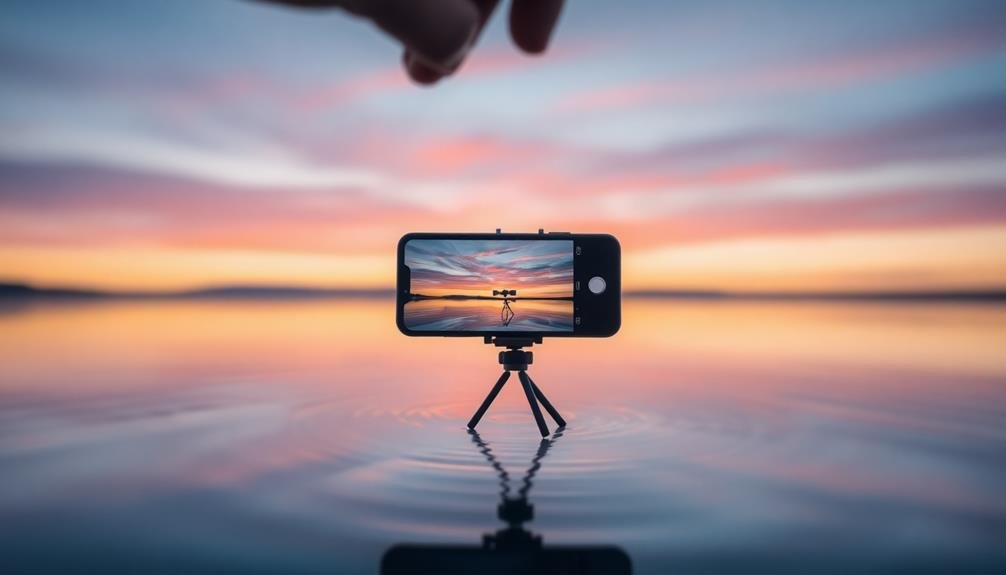
Now that you've mastered the art of timing, let's focus on keeping your smartphone steady for crystal-clear reflections. Stabilizing your device is essential for capturing sharp, detailed water reflections.
Start by holding your phone with both hands, keeping your elbows close to your body for added support. If possible, lean against a stable surface like a tree or wall to minimize body movement.
For even better results, consider investing in a lightweight, portable tripod designed for smartphones. These compact accessories can make a significant difference in image quality, especially in low-light conditions or when using slower shutter speeds.
If you don't have a tripod, improvise by resting your phone on a stable surface like a rock or bench.
Enable your phone's built-in image stabilization feature if available. Many modern smartphones offer optical or electronic stabilization, which can help reduce blur caused by small hand movements.
Additionally, use your phone's timer or voice commands to trigger the shutter, avoiding any shake from pressing the screen.
Clean Your Camera Lens
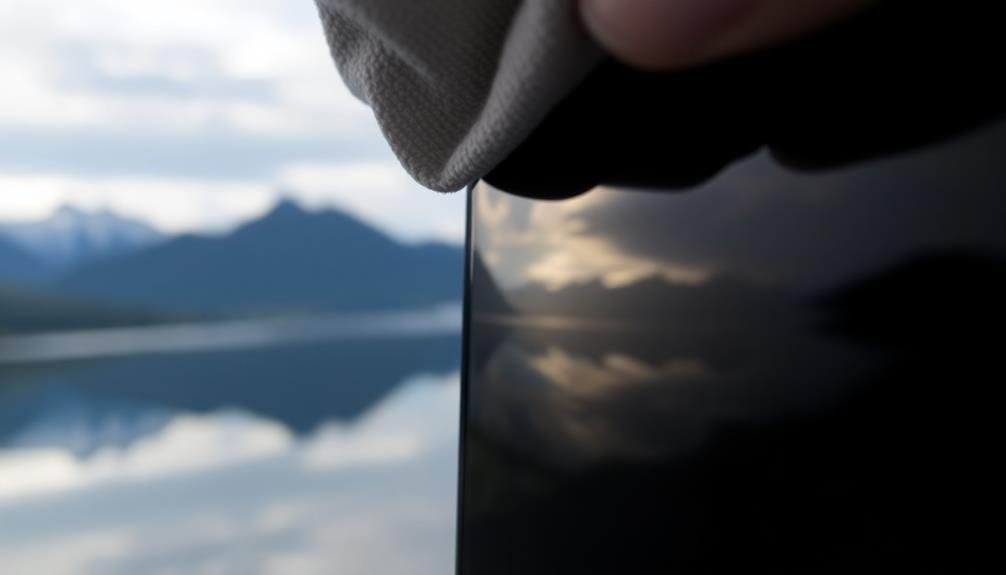
A clean lens is essential for capturing stunning water reflection photos. Even the tiniest smudge or speck of dust can ruin your shot, especially when dealing with reflections. Before you start shooting, take a moment to inspect your phone's camera lens.
To clean your lens effectively, use a microfiber cloth or lens cleaning wipes. Gently wipe the lens in a circular motion, starting from the center and moving outward. If there's stubborn dirt or grime, you can slightly dampen the cloth with distilled water or lens cleaning solution. Be careful not to use too much liquid, as it could seep into your phone and cause damage.
Here's a quick guide to lens cleaning:
| Cleaning Method | Pros | Cons |
|---|---|---|
| Microfiber Cloth | Reusable, gentle | Needs regular washing |
| Lens Wipes | Convenient, disposable | Can dry out if not sealed |
| Lens Pen | Precise, portable | Limited cleaning area |
Remember to clean your lens regularly, not just before a shoot. This habit will guarantee you're always ready to capture those perfect reflection shots when the opportunity arises. Don't forget to clean the front-facing camera lens too, as it's often overlooked but equally important for selfies and group shots.
Adjust Phone Camera Settings
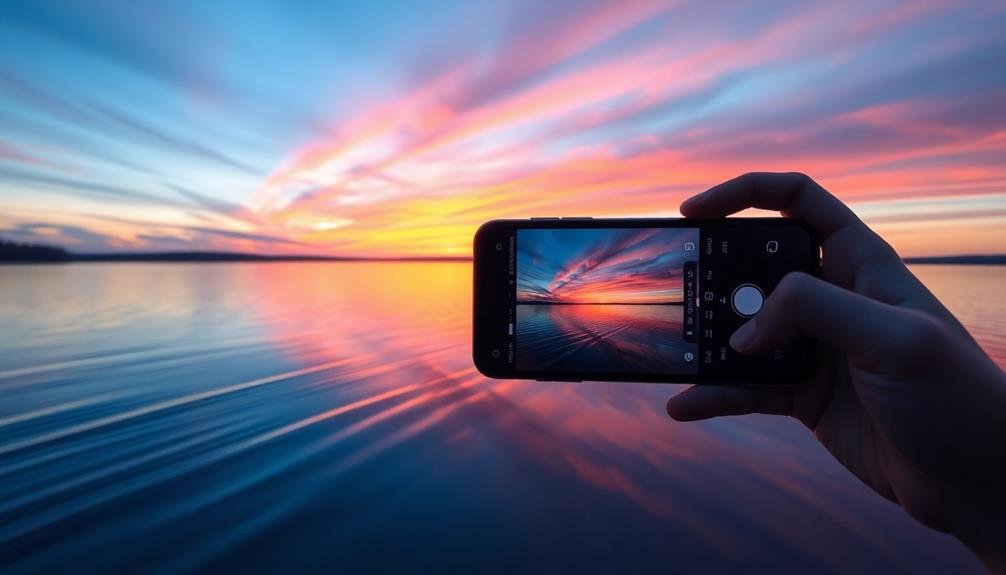
Frequently overlooked, adjusting your phone's camera settings can dramatically enhance the quality of your water reflection photos. Most modern smartphones offer advanced camera features that, when used correctly, can rival professional cameras.
To capture stunning water reflections, you'll want to focus on three key settings: exposure, focus, and HDR mode.
Start by adjusting your exposure. For reflections, you'll often need to lower the exposure slightly to prevent overexposing the sky while maintaining detail in the water.
Next, verify your focus is set correctly. Tap on the area of the screen where the reflection meets the shoreline to achieve peak sharpness.
Finally, consider using HDR mode for challenging lighting conditions. This feature can help balance the brightness between the sky and water, resulting in more detailed reflections.
Here are three additional tips to elevate your water reflection photography:
- Use gridlines to align your horizon perfectly
- Experiment with different angles and perspectives
- Try shooting during the golden hour for warm, soft lighting
Frame Your Shot Carefully
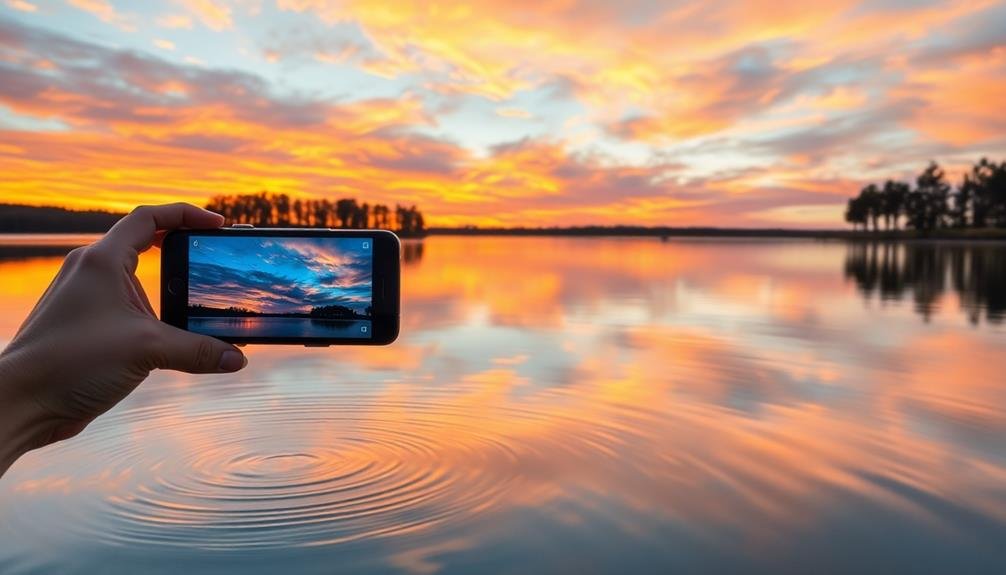
Framing your shot carefully is essential for creating enthralling water reflection photos. When composing your image, consider the rule of thirds to place key elements at intersecting points. Position the horizon line either in the upper or lower third of the frame, depending on whether you want to emphasize the sky or the water.
Look for interesting foreground elements like rocks, boats, or trees to add depth and context to your reflection. These objects can serve as leading lines, guiding the viewer's eye into the scene.
Pay attention to symmetry, as it's vital in reflection photography. Align your phone so that the real object and its reflection create a balanced composition.
Don't forget to experiment with different angles. Get low to the ground for a unique perspective, or try shooting from a higher vantage point to capture a broader view of the reflective surface. Consider including a person or animal in the shot to add scale and interest.
Experiment With Different Angles
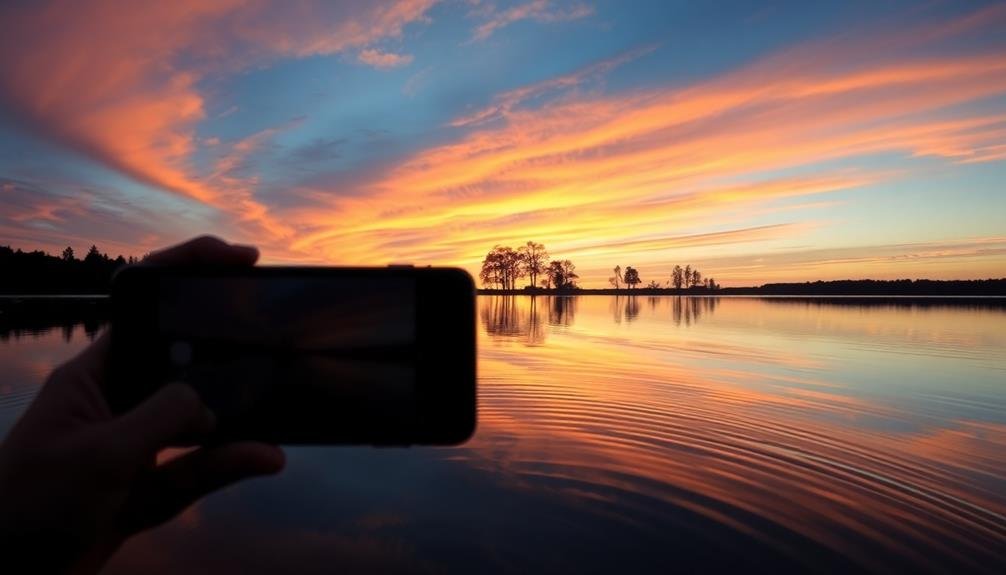
While framing your shot is important, exploring various angles can transform ordinary reflections into extraordinary images. Don't be afraid to get low, crouch down, or even lie on the ground to capture unique perspectives. By changing your position, you'll alter the relationship between the reflection and its surroundings, creating more dynamic compositions.
Consider shooting from different heights as well. Elevating your phone can provide a bird's-eye view of the reflection, while lowering it close to the water's surface can emphasize the mirror-like quality. Experiment with tilting your phone at various angles to play with the balance between the real subject and its reflection.
To make the most of different angles when capturing water reflections:
- Try shooting from directly above the water for a symmetrical, abstract look.
- Incorporate foreground elements by getting close to the ground and shooting across the water's surface.
- Experiment with diagonal compositions by positioning yourself at a 45-degree angle to the reflection.
Use Editing Apps Effectively
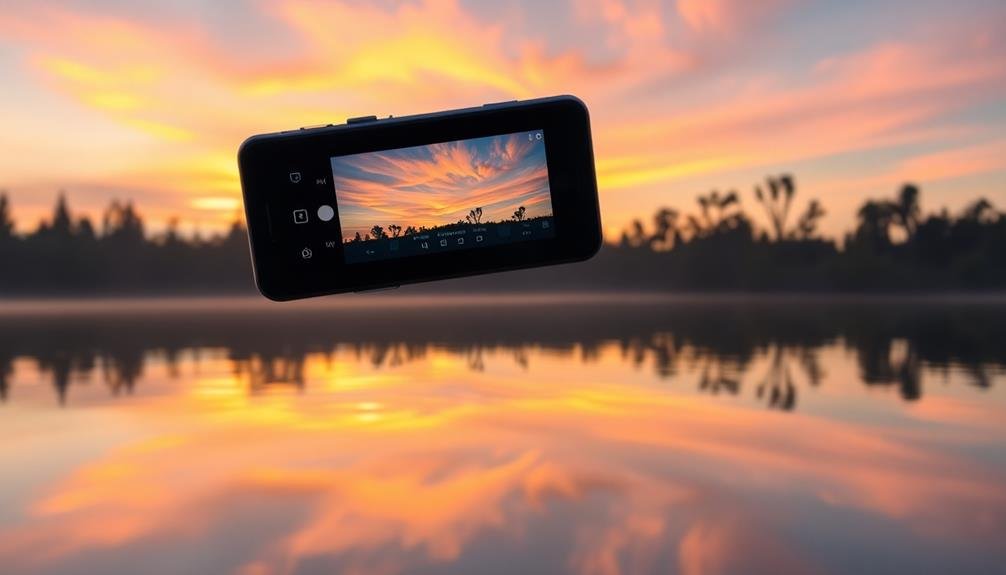
Once you've captured your water reflection photos, editing apps can take your images to the next level. Start by adjusting basic elements like brightness, contrast, and saturation to enhance the overall look. Pay special attention to the reflection's clarity and color balance.
Next, explore specialized tools for water reflections. Many apps offer features like symmetry adjustments, which can perfect the mirror effect. You'll also find water ripple effects to add subtle movement to still images. Don't forget to use selective editing tools to brighten specific areas or enhance details in the reflection.
Here's a quick guide to some popular editing apps and their key features for water reflection photos:
| App Name | Key Features | Difficulty Level |
|---|---|---|
| Snapseed | Selective editing, Curves tool | Intermediate |
| VSCO | Film-like filters, Advanced adjustments | Beginner |
| Lightroom Mobile | Dehaze tool, Powerful presets | Advanced |
Enhance Colors and Contrast
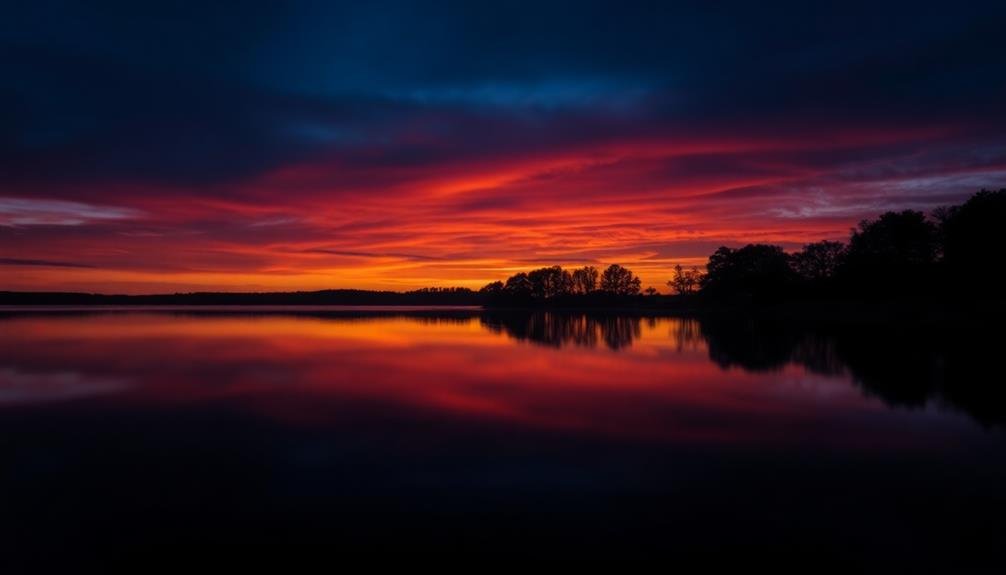
Enhancing colors and contrast can transform your water reflection photos from ordinary to extraordinary. With the right adjustments, you'll bring out the vibrancy and depth of your images, making them truly engaging.
Start by fine-tuning the exposure to guarantee a balanced distribution of light and dark areas. Then, focus on boosting the colors to make them pop without appearing unnatural.
When enhancing your water reflection photos, consider these key techniques:
- Adjust the saturation: Increase the color intensity to make the reflections more vivid, but be careful not to overdo it.
- Play with contrast: Enhance the difference between light and dark areas to create more definition in the reflections.
- Use selective editing: Apply adjustments to specific parts of the image, such as the sky or water, for a more refined look.
Don't forget to experiment with different color temperatures to achieve the desired mood. Cooler tones can create a serene atmosphere, while warmer hues add a golden glow to sunset reflections.
Create Symmetry in Compositions
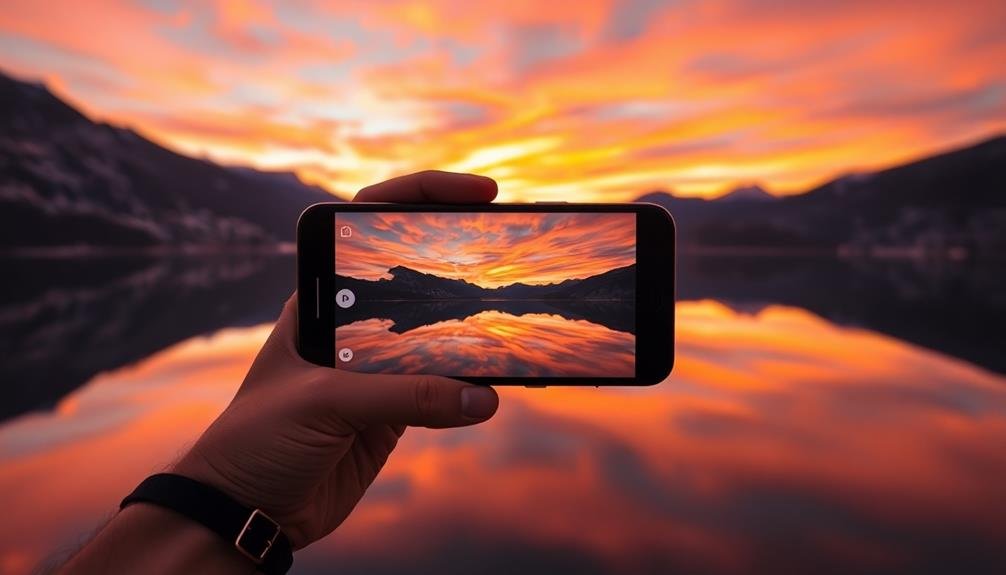
Symmetry can elevate your water reflection photos from eye-catching to breathtaking. To achieve this, position your phone's camera so that the water's edge bisects your frame horizontally. This creates a mirror-like effect, with the top half of your image reflected in the bottom half.
Look for scenes with strong vertical elements, such as trees, lamp posts, or buildings. These will create striking lines that draw the viewer's eye through both halves of your composition. Pay attention to the balance of elements on either side of your frame. While perfect symmetry can be powerful, slight asymmetry can add intrigue.
Use your phone's grid feature to align key elements precisely. If your scene isn't naturally symmetrical, you can create balance by adjusting your position or waiting for the right moment. For instance, if there's a boat on one side of the frame, wait until it moves to the center or until another boat enters the opposite side.
Don't forget to experiment with portrait orientation. Vertical symmetry can be just as impactful, especially when capturing tall structures or long reflections.
Capture Movement in Reflections

Movement in reflections can transform your water photos from static to dynamic. By capturing motion in the water's surface, you'll add depth and interest to your images. Look for opportunities to incorporate movement, such as ripples caused by wind, falling raindrops, or swimming wildlife. These elements can create intriguing patterns and distortions in the reflection, adding a unique dimension to your photos.
To effectively capture movement in reflections:
- Experiment with shutter speed: Use a faster shutter speed to freeze motion or a slower one to create a blurred, dreamy effect.
- Try burst mode: Capture a series of rapid-fire shots to increase your chances of getting the perfect moment of movement.
- Focus on the reflection: Confirm your phone's camera is focused on the reflection itself, not the water's surface, for sharper results.
Don't be afraid to get creative with your compositions. Try positioning yourself at different angles or heights to capture varied perspectives of the moving reflections.
Consider including contrasting elements, like a still object reflected in rippling water, to emphasize the sense of motion. With practice, you'll develop an eye for capturing fascinating movement in your water reflection photos.
Frequently Asked Questions
How Do I Protect My Phone From Water Damage While Shooting Reflections?
You can protect your phone from water damage while shooting reflections by using a waterproof case or pouch. Keep your device away from direct water contact, and consider using a tripod or selfie stick for added stability and distance.
Can I Use Filters or External Lenses for Better Reflection Photos?
You can definitely use filters and external lenses to enhance your reflection photos. Try a polarizing filter to reduce glare and boost contrast. Wide-angle or macro lenses can offer unique perspectives. Experiment with different options to find your style.
What's the Best Way to Focus on Both the Subject and Reflection?
To focus on both subject and reflection, use a smaller aperture (higher f-number) for increased depth of field. You'll want to focus about one-third into the scene. If possible, try manual focus for more control.
How Do I Reduce Glare on the Water Surface When Photographing Reflections?
To reduce glare when photographing reflections, you'll want to use a polarizing filter. If you don't have one, try adjusting your angle or shooting during golden hour when the sun's lower. You can also experiment with different exposure settings.
Are There Specific Weather Conditions That Enhance Water Reflection Photography?
You'll get the best water reflections on calm, windless days. Overcast skies or golden hour lighting can enhance colors and contrast. Early morning or late evening often provide still water and soft light, perfect for reflections.
In Summary
You've now got the tools to create stunning water reflection photos with your smartphone. Remember, it's all about finding the right water source, timing, and camera settings. Don't forget to stabilize your phone and keep that lens clean. With practice and some post-processing magic, you'll be capturing breathtaking reflections in no time. So get out there, experiment, and let your creativity flow. Your next masterpiece is just a click away!

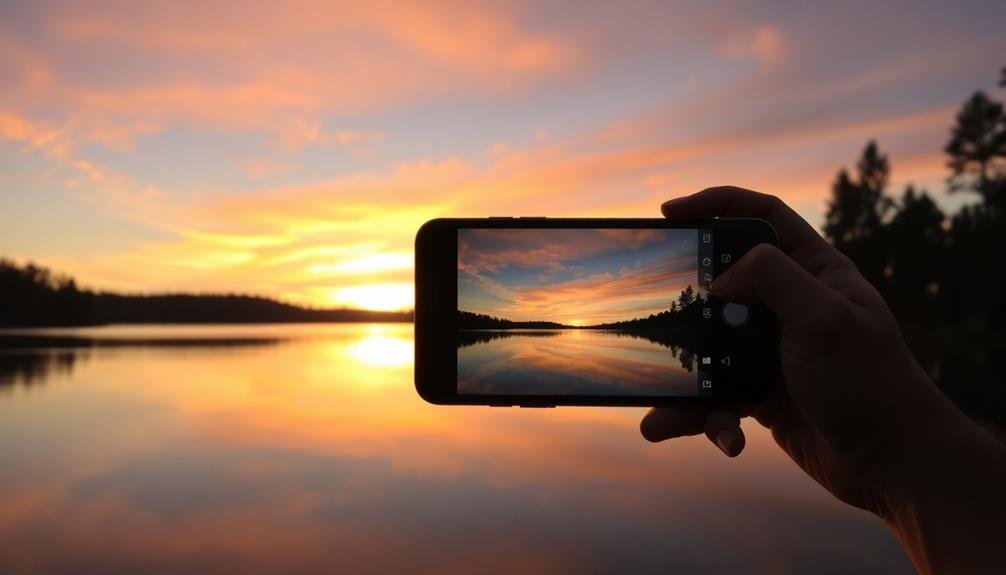



Leave a Reply